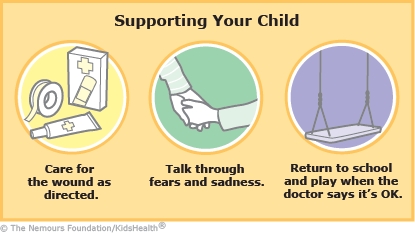After a Severe Dog Bite: How to Care for Your Child
With proper care, most severe dog-bite wounds will heal, although some scarring can remain.


Your child had a serious dog-bite injury. While in the hospital, the wound was checked thoroughly and carefully cleaned. Any dead tissue was removed from the wound. X-rays or other tests might have been done to check for damage to muscles, bones, tendons, or nerves.
Different specialists — such as a plastic surgeon, orthopedic (bone) doctor, and/or the trauma team — worked together to care for your child and repair the damaged tissue. Your child might have had a skin graft or stitches. The health care providers may have given medicines to ease pain and anxiety during procedures or dressing changes.
A dog's mouth contains germs, so there is an infection risk with a dog bite. Some dog-bite wounds are left open at first and closed after a few days to decrease the chance of infection. Your child was given intravenous (IV) antibiotics and then oral antibiotics in the hospital.
Your child's immunizations (shots) were updated, if needed, to help prevent infection. Now your child is ready to go home. The wound will continue to heal and look better over the next several weeks to months. Continuing good wound care is very important.

-
Continue caring for your child's wound as instructed.
-
Give your child all of the antibiotics as prescribed by your health care provider.
-
You may give your child acetaminophen or ibuprofen as directed for pain or discomfort.
-
Follow your health care provider's instructions about bathing, participating in sports, and returning to school or childcare.
-
Keep your child and any pets in your home up to date on their shots.
-
Teach your child how to approach dogs safely.


Your child:
-
Has a fever of 101°F (38.3°C) or higher.
-
Has increased redness, swelling, or drainage of pus from the wound.
-
Experiences worsening pain.


Having a serious animal bite can be very scary. It may take a while for your child to work through the difficult emotions of this experience. Your child may have bad dreams or flashbacks, or be afraid around dogs. If you had to put your pet down, your child also might be dealing with feelings of sadness and loss.
It is normal to feel stress and fear at first, but if these symptoms go on for months, your child should be evaluated for post-traumatic stress disorder (PTSD), which is common in kids after dog bites. It might be helpful to work with a psychologist or counselor to help your child through this process.